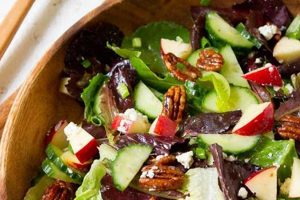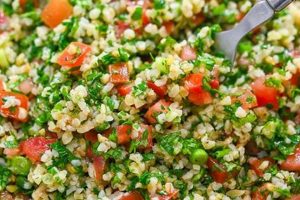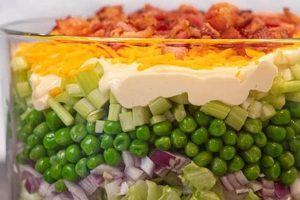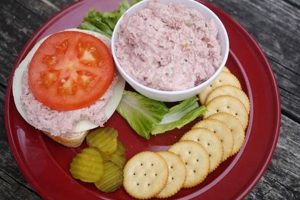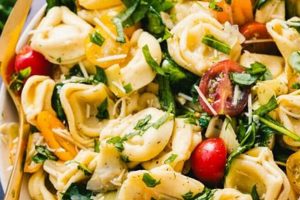This dish features thinly sliced or coined carrots, often glazed with a sweet and tangy dressing. The name derives from the resemblance of the carrot slices to the small, round, and often bright copper pennies. Variations exist, incorporating ingredients such as raisins, pineapple, or nuts, and dressings range from simple vinaigrettes to richer, creamier options.
The appeal lies in the salad’s combination of sweetness, tang, and satisfyingly crisp texture. It serves as a refreshing counterpoint to heavier dishes and offers a visually appealing addition to any meal, particularly potlucks, picnics, or holiday gatherings. The dish’s affordability and ease of preparation further contribute to its popularity as a side dish. It’s also a good way to incorporate more vegetables, especially for those who may not typically enjoy raw carrots.
This discussion will further explore various preparation methods, ingredient variations, and serving suggestions for this classic salad. Nutritional information and tips for achieving optimal flavor and texture will also be provided.
Tips for a Perfect Carrot Salad
Achieving optimal flavor and texture in a carrot salad requires attention to detail. The following tips offer guidance for creating a truly exceptional dish.
Tip 1: Carrot Selection and Preparation: Choose firm, fresh carrots without blemishes. Uniform slicing ensures even cooking and a pleasant presentation. A mandoline slicer yields consistent, thin rounds, while a sharp knife allows for more rustic, varied shapes.
Tip 2: Enhancing Carrot Flavor: Briefly blanching carrots in boiling water can heighten their sweetness and soften their texture slightly, while retaining a pleasant crunch. Immediately plunging the blanched carrots into ice water stops the cooking process and preserves their vibrant color.
Tip 3: Dressing Considerations: The dressing should complement the carrots’ natural sweetness. A balance of acidity, sweetness, and a touch of salt is key. Allowing the carrots to marinate in the dressing for at least 30 minutes enhances flavor absorption.
Tip 4: Incorporating Additional Ingredients: Raisins or other dried fruits add sweetness and textural contrast. Chopped nuts, such as pecans or walnuts, offer a satisfying crunch and subtle earthy notes. Thinly sliced red onions provide a pungent bite.
Tip 5: Storage and Serving: Refrigerate the salad for at least an hour before serving to allow the flavors to meld. Serve chilled. The salad can typically be stored in an airtight container in the refrigerator for up to three days.
Tip 6: Presentation: A simple yet elegant presentation enhances the dining experience. Consider garnishing with fresh herbs, such as parsley or mint, for a touch of visual appeal and added freshness.
By following these tips, one can elevate a simple carrot salad to a truly memorable dish, showcasing the versatility and deliciousness of this humble vegetable.
The following section concludes this exploration of carrot salad preparation.
1. Thinly sliced carrots
Thinly sliced carrots are fundamental to the copper penny carrot salad, contributing significantly to both its aesthetic appeal and textural experience. The thinness of the slices is integral to the salad’s identity, differentiating it from other carrot-based dishes.
- Visual Resemblance:
The thin, round carrot slices evoke the image of copper pennies, hence the salad’s name. This visual connection is a key characteristic of the dish, making it instantly recognizable and adding a touch of whimsy.
- Texture and Mouthfeel:
Thinly slicing the carrots creates a delicate, tender texture that contrasts pleasantly with other ingredients, such as nuts or raisins. This contributes to a more enjoyable eating experience.
- Flavor Absorption:
The increased surface area of thinly sliced carrots allows for greater absorption of the dressing’s flavors, ensuring that each bite is infused with the desired sweet and tangy notes. This maximizes the impact of the dressing and enhances the overall flavor profile.
- Ease of Preparation:
While various tools can achieve thin slices, from a simple sharp knife to a mandoline slicer, the relative ease of this preparation step contributes to the salad’s popularity as a quick and convenient dish.
The thinness of the carrot slices is therefore not merely a culinary technique but a defining feature of the copper penny carrot salad. It influences the dish’s appearance, texture, flavor, and ease of preparation, ultimately contributing to its enduring appeal as a classic side dish.
2. Sweet and tangy dressing
The sweet and tangy dressing is integral to a successful copper penny carrot salad, providing a crucial balance of flavors that complements the natural sweetness of the carrots. This balance is achieved through a careful interplay of acidic and sweet components, often incorporating ingredients like vinegar, sugar, or citrus juice. The dressing not only enhances the carrots’ inherent flavor but also contributes to the overall sensory experience.
The tangy element, typically derived from vinegar (such as apple cider or white wine vinegar), provides brightness and cuts through the sweetness, preventing the salad from becoming cloying. The sweetness, often from granulated sugar, honey, or maple syrup, adds depth and rounds out the flavor profile. This interplay creates a dynamic taste experience that elevates the simple ingredients. A well-balanced dressing clings lightly to the thinly sliced carrots, ensuring each bite delivers the intended flavor combination. Furthermore, the acidity in the dressing can help to preserve the bright orange color of the carrots, enhancing the visual appeal of the salad.
Variations in dressing recipes showcase the adaptability of this core element. For example, the inclusion of Dijon mustard can add a subtle sharpness, while a touch of ginger or garlic introduces a more complex flavor dimension. The choice of oil also influences the dressing’s character; a light olive oil offers a delicate flavor, while a more robust oil like walnut oil can add a richer, nuttier note. Ultimately, the synergy between the sweet and tangy elements of the dressing defines the character of the copper penny carrot salad, transforming it from a simple collection of ingredients into a harmonious and flavorful dish.
3. Visual appeal
Visual appeal plays a significant role in the overall enjoyment of a copper penny carrot salad. The presentation elevates the dish beyond mere sustenance, transforming it into a more engaging culinary experience. The intentional arrangement and color contrast contribute to this appeal, making the salad visually enticing.
- Color Contrast:
The vibrant orange of the carrots provides a striking base. This color can be further enhanced by the strategic inclusion of contrasting ingredients. Darker elements, such as raisins or chopped walnuts, create visual interest against the bright carrots. Green garnishes, like parsley or mint, offer a refreshing counterpoint, further amplifying the visual appeal.
- Uniformity of Shape:
The consistent, thin round shape of the carrot slices, reminiscent of copper pennies, contributes to a pleasing visual uniformity. This precision adds a touch of elegance and professionalism to the presentation, suggesting careful preparation and attention to detail.
- Garnishes and Serving Dishes:
The choice of serving dish and garnishes can further enhance the salad’s visual appeal. A clear glass bowl allows the vibrant colors of the salad to shine through, while a rustic wooden bowl offers a more informal, natural aesthetic. Simple garnishes, such as a sprinkle of chopped nuts or a scattering of fresh herbs, add the finishing touch, elevating the presentation.
- Light and Texture:
The interplay of light reflecting off the glossy surface of the carrots and the matte texture of added ingredients creates visual depth and interest. This contrast captures the eye and enhances the perceived freshness of the ingredients, adding another layer of visual appeal.
The visual appeal of a copper penny carrot salad is integral to its overall success. The interplay of color, shape, texture, and presentation elevates the dish from simple to sophisticated, making it as visually satisfying as it is flavorful. This attention to visual detail enhances the dining experience, making the salad a welcome addition to any table.
4. Simple preparation
The ease of preparation is a defining characteristic of the copper penny carrot salad recipe, contributing significantly to its enduring popularity. Minimal culinary expertise and readily available ingredients make this salad accessible to a wide range of individuals, regardless of their cooking experience. This simplicity also lends itself to quick preparation, making it an ideal choice for busy weeknight meals or last-minute additions to potlucks and gatherings.
- Minimal Ingredients:
The recipe typically requires only a few core ingredients: carrots, dressing components (oil, vinegar, sweetener), and optional additions like raisins or nuts. This streamlined ingredient list simplifies the shopping process and reduces preparation time.
- Basic Equipment:
Specialized equipment is not necessary. A sharp knife or a mandoline slicer for preparing the carrots, a bowl for mixing, and basic measuring tools are typically sufficient. This accessibility further contributes to the ease and convenience of the recipe.
- Quick Assembly:
Once the carrots are sliced, the salad can be assembled quickly. The dressing is typically whisked together and then combined with the carrots and any other chosen ingredients. The minimal active preparation time makes this an ideal dish for those seeking a quick and easy meal option.
- Adaptability and Flexibility:
The simple nature of the recipe allows for considerable adaptability. The dressing can be customized to suit individual preferences, and the inclusion of additional ingredients, such as different nuts, dried fruits, or herbs, allows for personalization without adding complexity to the preparation process. This flexibility contributes to the salads versatility and broad appeal.
The simplicity of preparation is a key factor in the enduring popularity of the copper penny carrot salad. This ease of assembly, combined with the recipe’s adaptability, ensures its continued presence on tables from everyday meals to special occasions. The minimal time commitment required allows cooks to focus on other culinary endeavors or simply enjoy more time with guests, reinforcing the salad’s value as a convenient and flavorful dish.
5. Versatile ingredients
The versatility of ingredients contributes significantly to the enduring appeal of the copper penny carrot salad. This adaptability allows for customization based on personal preferences, dietary restrictions, and seasonal ingredient availability. The basic recipe provides a foundation upon which numerous variations can be built, ensuring the salad remains interesting and adaptable to diverse culinary contexts. This flexibility also contributes to minimizing food waste, as leftover ingredients from other dishes can be easily incorporated.
The core ingredient, carrots, offers inherent versatility. Different carrot varieties, such as Nantes or Imperator, introduce subtle variations in sweetness and texture. Preparation methods, including grating, shredding, or julienning, further expand the possibilities, each offering a unique textural element to the final dish. Beyond carrots, the salad readily accommodates a wide array of additions. Dried fruits like raisins, cranberries, or chopped apricots contribute sweetness and chewiness. Nuts, such as walnuts, pecans, or slivered almonds, introduce textural contrast and healthy fats. Seeds, like sunflower or pumpkin seeds, provide additional nutritional value. Fresh herbs, such as parsley, mint, or cilantro, introduce aromatic complexity and visual appeal. Even shredded coconut or crumbled feta cheese can find a place within this adaptable recipe.
This ingredient versatility offers practical benefits. Seasonal adjustments are straightforward; spring versions might incorporate fresh peas or chopped scallions, while autumnal iterations might feature dried cranberries and toasted pecans. Dietary adaptations are equally simple; omitting nuts accommodates allergies, while substituting honey for sugar caters to specific dietary preferences. This inherent adaptability allows the copper penny carrot salad to remain a relevant and enjoyable dish across a wide range of culinary situations and individual needs. The ability to personalize the recipe ensures its continued appeal, solidifying its position as a versatile and adaptable culinary staple.
6. Nutritional Value
Nutritional value is an important consideration within the context of a copper penny carrot salad recipe. While renowned for its flavor and visual appeal, this salad also offers notable health benefits derived from its key ingredients, particularly carrots. Understanding these nutritional components provides a more comprehensive appreciation for this versatile dish.
- Vitamins and Minerals:
Carrots are an excellent source of beta-carotene, a precursor to vitamin A, crucial for maintaining eye health and supporting immune function. They also provide potassium, an electrolyte essential for regulating blood pressure and muscle function, and vitamin K, important for blood clotting and bone health. The inclusion of other ingredients, such as nuts and dried fruits, can further enhance the vitamin and mineral content of the salad.
- Fiber Content:
Carrots are a good source of dietary fiber, which promotes digestive health and contributes to feelings of satiety. Fiber plays a role in regulating blood sugar levels and can help lower cholesterol. Including additional high-fiber ingredients, such as raisins or other dried fruits, further boosts the salads fiber content.
- Antioxidants:
Carrots contain antioxidants, including beta-carotene and other carotenoids, which protect cells from damage caused by free radicals. These antioxidants contribute to overall health and well-being and may play a role in reducing the risk of certain chronic diseases.
- Low in Calories and Fat:
Copper penny carrot salad, particularly when prepared with a light vinaigrette, is generally low in calories and fat, making it a suitable choice for those seeking to manage their weight or maintain a healthy diet. This allows for greater portion sizes while keeping caloric intake in check.
The nutritional value of a copper penny carrot salad enhances its appeal as a healthful and flavorful dish. The combination of vitamins, minerals, fiber, and antioxidants contributes to overall well-being, while its relatively low calorie and fat content makes it a suitable component of a balanced diet. Understanding the nutritional benefits elevates this simple salad from a pleasant side dish to a valuable contribution to a health-conscious meal plan.
7. Adaptable Flavors
The adaptability of flavors is a defining characteristic of the copper penny carrot salad, distinguishing it from more rigidly defined recipes. This inherent flexibility allows the salad to transcend individual preferences and accommodate diverse culinary traditions, ensuring its continued relevance across a broad spectrum of palates and occasions. This adaptability stems from the salad’s capacity to seamlessly integrate a wide array of flavor profiles, ranging from sweet and spicy to savory and tangy.
- Sweetness Modulation:
The level of sweetness can be readily adjusted to suit individual preferences and intended pairings. From the subtle sweetness of maple syrup to the robust sweetness of honey or the tangy sweetness of dried fruits like raisins or cranberries, the spectrum of sweet elements offers ample room for customization. Balancing this sweetness against the tangy components of the dressing is crucial for achieving a harmonious flavor profile.
- Tangy Accents:
The tangy dimension, often provided by vinegar or citrus juice, offers a counterpoint to the sweetness of the carrots and other ingredients. Apple cider vinegar contributes a mild, fruity tang, while white wine vinegar provides a sharper, more assertive acidity. Lemon or lime juice can introduce a citrusy brightness, further enhancing the complexity of the salad’s flavor profile. The careful balance of tangy and sweet elements defines the character of the dressing and the overall salad.
- Spice Integration:
Incorporating spices opens up a realm of flavor possibilities. A pinch of ground ginger adds warmth and complexity, while a dash of cayenne pepper introduces a subtle heat. Ground cumin or coriander can lend an earthy, savory dimension. These spice additions, used judiciously, can transform the salad from a simple side dish into a more complex and intriguing culinary creation.
- Herbal Enhancements:
Fresh herbs contribute a vibrant freshness and aromatic complexity. Chopped parsley provides a classic, clean flavor, while mint offers a cooling, refreshing counterpoint. Cilantro introduces a more pungent, citrusy note. The choice of herbs can significantly influence the overall flavor profile, adding another layer of customization to the salad.
The adaptability of flavors within the copper penny carrot salad recipe is central to its versatility and enduring appeal. The capacity to seamlessly integrate sweet, tangy, spicy, and herbal notes allows for a wide range of flavor combinations, ensuring the salad complements diverse menus and satisfies a broad spectrum of palates. This inherent flexibility allows the salad to remain a relevant and refreshing dish across generations and culinary traditions.
Frequently Asked Questions
This section addresses common inquiries regarding copper penny carrot salad preparation and variations.
Question 1: What is the origin of the name “copper penny” carrot salad?
The name derives from the resemblance of the thinly sliced carrots to small, shiny copper pennies. This visual analogy adds a touch of whimsy to the dish.
Question 2: Can other vegetables be added to this salad?
While carrots are the central ingredient, other vegetables can complement the salad. Finely shredded red cabbage adds color and texture, while thinly sliced celery offers a crisp counterpoint. However, it’s crucial to maintain the prominence of carrots to preserve the salad’s identity.
Question 3: What type of vinegar is best suited for the dressing?
Apple cider vinegar is a popular choice, offering a mild, fruity acidity that complements the sweetness of the carrots. White wine vinegar provides a sharper tang, while rice vinegar offers a milder, slightly sweeter flavor. The choice depends on individual preference and desired flavor profile.
Question 4: How can the salad’s sweetness be adjusted?
The sweetness can be modulated through the choice of sweetener and its quantity. Granulated sugar offers a clean sweetness, while honey or maple syrup adds a richer, more complex sweetness. Adjusting the amount of sweetener allows for customization to individual preferences.
Question 5: How long can the salad be stored?
Properly stored in an airtight container in the refrigerator, the salad typically remains fresh for up to three days. However, optimal texture and flavor are best enjoyed within the first two days.
Question 6: Can this salad be served as a main dish?
While traditionally served as a side dish, the salad can become a more substantial meal with the addition of protein. Grilled chicken or chickpeas complement the flavors and enhance the nutritional value, transforming the salad into a satisfying main course.
These responses provide clarity on common preparation techniques and ingredient variations. Experimentation with different flavors and additions is encouraged to personalize the salad.
The next section will offer a concluding summary of the copper penny carrot salad’s attributes.
Copper Penny Carrot Salad Recipe
This exploration has provided a comprehensive overview of the copper penny carrot salad recipe, encompassing its historical context, ingredient versatility, nutritional value, flavor profiles, and preparation techniques. The characteristic thin carrot slices, resembling copper pennies, define its visual identity, while the balanced interplay of sweet and tangy flavors in the dressing establishes its distinctive taste. The simplicity of preparation, combined with the adaptability of ingredients, positions this salad as a versatile culinary option suitable for diverse occasions and palates.
The enduring popularity of this salad underscores its timeless appeal. From everyday meals to festive gatherings, the copper penny carrot salad offers a refreshing, flavorful, and nutritious contribution to any culinary landscape. Its adaptability ensures relevance in contemporary kitchens, allowing for creative interpretations while maintaining its core identity. This exploration encourages further culinary experimentation, emphasizing the potential for personalized variations within this classic recipe.

